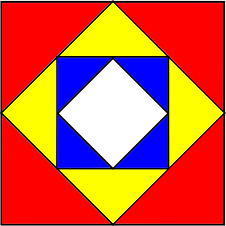
 |
Exam-Style Question on SequencesA mathematics exam-style question with a worked solution that can be revealed gradually |
Question id: 50. This question is similar to one that appeared on an IB Standard paper in 2014. The use of a calculator is not allowed.
A square is drawn with sides of length 32 cm. The midpoints of the sides of this square are joined to form a new square and four red triangles. The process is repeated to produce yellow triangles and then again to produce blue triangles.

The length of the equal sides of the red triangles are denoted by \(x_1\) and their areas are each \(A_1\).
The length of the equal sides of the yellow triangles are denoted by \(x_2\) and their areas are each \(A_2\).
The length of the equal sides of the blue triangles are denoted by \(x_3\) and their areas are each \(A_3\).
(a) The following table gives the values of \(x_n\) and \(A_n\), for \(1\le n\le3\). Copy and complete the table.
| \(n\) | 1 | 2 | 3 |
| \(x_n\) | 16 | ||
| \(A_n\) | 128 |
(b) The process of drawing smaller and smaller squares inside each new square is repeated. Find \(A_7\)
(c) Consider an initial square of side length \(k\) cm. The process described above is repeated indefinitely. The total area of one of each colour triangles is \(k\) cm2. Find the value of \(k\).
|
The worked solutions to these exam-style questions are only available to those who have a Transum Subscription. Subscribers can drag down the panel to reveal the solution line by line. This is a very helpful strategy for the student who does not know how to do the question but given a clue, a peep at the beginnings of a method, they may be able to make progress themselves. This could be a great resource for a teacher using a projector or for a parent helping their child work through the solution to this question. The worked solutions also contain screen shots (where needed) of the step by step calculator procedures. A subscription also opens up the answers to all of the other online exercises, puzzles and lesson starters on Transum Mathematics and provides an ad-free browsing experience. |

|

Drag this panel down to reveal the solution
If you need more practice try the self-checking interactive exercise called Sequences and Series.
The exam-style questions appearing on this site are based on those set in previous examinations (or sample assessment papers for future examinations) by the major examination boards. The wording, diagrams and figures used in these questions have been changed from the originals so that students can have fresh, relevant problem solving practice even if they have previously worked through the related exam paper.
The solutions to the questions on this website are only available to those who have a Transum Subscription.
Exam-Style Questions Main Page
To search the entire Transum website use the search box in the grey area below.
©1997 - 2025 Transum Mathematics :: For more exam-style questions and worked solutions go to Transum.org/Maths/Exam/